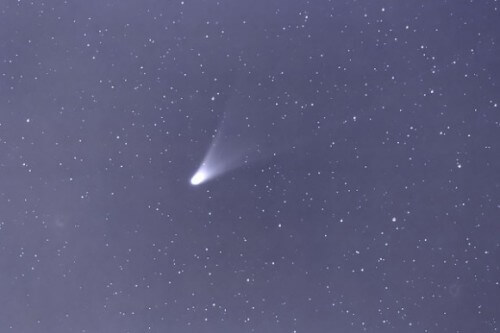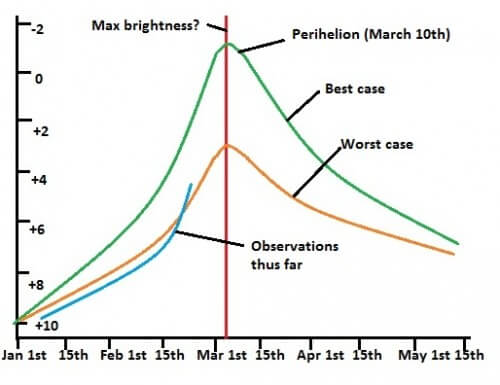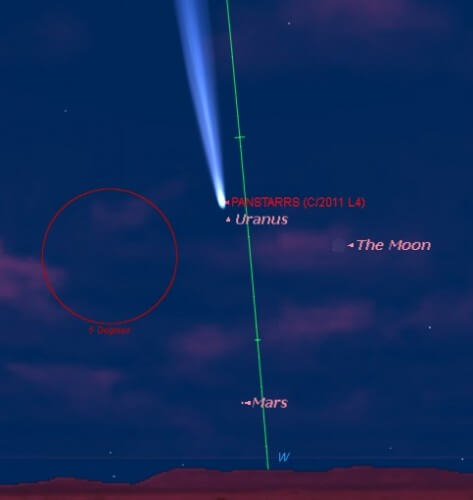After a long wait, it will be possible to observe this year's comet with the naked eye even from the Northern Hemisphere at the beginning of March.

As we mentioned in a previous article, 2013 could be the year of the comets with two bright comets already providing a display for viewers in the Southern Hemisphere and Comet Ison expected to complete the celestial spectacle later this year. However, while Comet Lemmon (C/2012 F6 Lemmon) will not be visible in the Northern Hemisphere until April, Comet C/2011 L4 PanSTARRS (hereafter PanSTARRS) will be clearly visible in the early evening hours in the first two weeks of March and that of course - if it appears.
Comets sometimes behave like cats, so people like to spread their pictures on the Internet. They often refuse to perform according to our expectations. Some comets were a pleasant surprise, such as Hale Bop in 1997. Others, such as Kohotek in 1973-74, did not live up to expectations of being very bright, and they disappeared into obscurity and oblivion.

Comet PanStars was discovered on June 6, 2011 using a telescope designed to detect near-Earth objects, the Panoramic Survey Telescope and Rapid Response System, and its name is simply the acronym for the name of the project (PanSTARRS) installed on the summit of Mount Alkakala on the island of Maui. The astronomers knew that it would have the potential to become a bright comet thanks to its discovery at a distance of 7.9 astronomical units from the Sun (one astronomical unit is the distance from the Earth to the Sun about 150 million kilometers). The comet brightened even more than expected and was observed for the first time by an amateur astronomer on March 28, 2012 (H. Gonzalez Malone, Spain9 at brightness 14.)
The comet is now in the constellation Agor at a distance of 1.18 AU from Earth and is already providing a spectacular display for viewers in the southern hemisphere. Photographer and astronomer Luis Argrich of Buenos Aires provided us with some images of the comet as it begins to grow a dust tail. Argrich estimates that comet Panstars already reached magnitude 4 earlier this week, slightly dimmer than the star Alpha Indi which is magnitude XNUMX.

.
Comet Panstars will begin moving north during the last week of February. This is because the comet has a hyperbolic orbit with an inclination of 84.2 degrees relative to the Milka plane, that is, almost perpendicular. With an orbit that spanned over 110 years, this means that this is most likely the first journey of Fanstars through the inner solar system.
However, the serious activity will come at the beginning of March when Comet Fanstars will reach a height of more than 5 degrees for observers at the latitude 30 degrees north in a southwest direction starting on March 5th. On that day, the comet will also reach its closest distance to Earth - 1.1 astronomical units.
The comet will then continue north, passing less than one degree from the star at magnitude 3.5 Lola Seti. The comet will reach perihelion - the closest point to the Sun, at a distance of 0.3 astronomical units, that is, slightly outside the orbit of Hema on March 10.
After reaching the height peak - 15-20 degrees above zero in the Northern Hemisphere, Comet Fanstars will continue parallel to the western horizon all the following evenings. In the first half of March, the comet will have the opportunity to be at its peak brightness. In the best case it will reach minus 1 degree when the tail will point above the horizon like an exclamation mark. In the worst case, it will be a dim comet at magnitude plus 3 and will only be visible with the help of binoculars.

If you only have one chance to watch the comet, it should be done on the evening of the 12th or 13th of March. The comet will cross the Milka plain and join the thin crescent moon which will be one day old. If you have binoculars or a telescope it will be possible to follow the planet Oron (Uranus) at magnitude 6, only about half as high as the comet's head on March 12.
The comet will then continue its course north through the Pisces constellation to Andromeda later in March, crossing within three degrees of the galaxy M31 on April 3. It will cross the galactic plane in Cassiopeia on April 25 to May 1 when the comet will return and be dim beyond the range of the naked eye. Hopefully it will be after a spectacular show.
This is the first bright comet to be seen in the Northern Hemisphere since the improvements in DSLR astrophotography. In the 2006s we had bright comets like Hale-Bopp and Ahyatoka but then we only had film cameras, and Comet C/1 P2007 McNaught appeared at its brightest in XNUMX but only to observers in the southern hemisphere. We expect some spectacular images if the comet lives up to astronomers' expectations.

5 תגובות
Starting tomorrow (March 12, 13 and 14) the best conditions will be created to see Comet Pan-Stars without instruments (although it is not certain that it will actually be possible to see it without instruments).
As I mentioned in a previous comment, the comet appears on the west side (it will appear slightly south of the moon's orbit at sunset). The best altitude at which the comet will be visible (if it can be seen) is when
The comet is 7 degrees above the horizon. The comet will also set on the west side, therefore there is a short time window of (it is said) fifteen minutes in which it can be seen (without instruments).
According to my memory, the comet will be 7 degrees above the horizon about 50 minutes after sunset (which will ensure that the twilight light of the sunset will be quite weak and will not interfere too much with the observation). Not ready to sign the number 50 minutes, it is taken from my memory, in any case the exact number is something between 40 minutes and 60 minutes after sunset.
The chance of seeing the comet depends on its brightness. If its brightness is for example -1 (magnitude -1) there is a good chance to spot it without instruments on one of the three days mentioned. According to an article I just read, its brightness today is -0.2 (meaning less bright than -1). If this information is correct, the brightness on the days of observation will be lower than -1 (for example - brightness -0.5) but even at brightness -0.5 there is a chance to see the comet without instruments.
There was an error in my previous response that led to incorrect conclusions. Below is the explanation.
The article is about an observation of the comet when it is 5 degrees above the horizon, when the observation is made from the 30 degree latitude. Since Israel is at 32 degrees latitude, the comet's position above the horizon changes by two degrees. The wrong position I mentioned was 3 degrees above the horizon line, the correct position in observation is 7 degrees above the horizon line. This difference is very significant in terms of observation ability even though it is a few degrees. Observation of a comet when it is observed above the horizon line at a height of 3 degrees is almost impossible, because the ground haze (in addition to the twilight light in the viewing area)
The appearance of the comet is almost completely eliminated. Conversely, if the comet is observed at the same time when it is 7 degrees above the horizon, its appearance is much more prominent. The ability to observe the comet on the mentioned days is not yet known because it is difficult to estimate its brightness. It is estimated that its brightness on the said day and time will be a brightness of about minus 0.7 in the best case and plus 3 in the worst case. If its brightness will be minus 0.7 he will see well, if his brightness will be plus 3 on that day and hour he will not see at all, if his brightness will be 0 on that day and at that time he will see barely. You have to wait for the expected brightness assessment to know in advance if it is worth observing. A good brightness assessment can be given on the 10th and 11th of March, on March 11th the assessment will probably be more accurate than the assessment on March 10th. The best observation days will probably be March 12, 13, 14. The position of the comet will be on the west side. The best observation time will be about one hour after sunset.
Israel at a longitude of about 35. Our latitude is about 32……
The angles indicated here are not viewing angles in Israel. Israel is at a longitude coordinate of 32 degrees
And not the 30 longitude coordinate that is discussed in the article here. This means that the comet is 2 degrees closer to the horizon than indicated here. If I understood correctly during the viewing on March 13, the comet is supposed to flood when it is 3 degrees above the horizon, in most urban areas of the country visibility at this angle is poor due to haze, if the brightness of the comet is minus 1 viewing it is borderline, if its brightness is only 0 I doubt if it will be seen without instruments. You need to follow a report two days before the sighting to assess if it can be seen in Israel at all. I assume that Gael Fatal will report in his articles on Ynet.
Regarding the observation, it should be taken into account that the lighting in the sky is twilight light and not night lighting as seen in the diagrams. In twilight lighting in the place in the sky where the comet will be found. —
It is not possible to see a celestial gram with a brightness of 0, especially if it is observed in an orbit close to Mercury, this is because Mercury is close to the Sun, therefore the twilight light there is a strong light.